Management of Used Oil at Hazardous Waste Facilities
VerifiedAdded on 2020/05/11
|7
|1301
|130
Report
AI Summary
The report addresses the management responsibilities for handling large quantities of used oil at a facility. It explores the chemical properties of used oil, its potential health risks such as cancer, and environmental impacts including pollution from spills. Recommendations include training employees, using appropriate storage containers, regular audits, and adhering to EPA guidelines for treatment options like re-refining and burning. These measures aim to mitigate the adverse effects associated with improper handling of used oil.
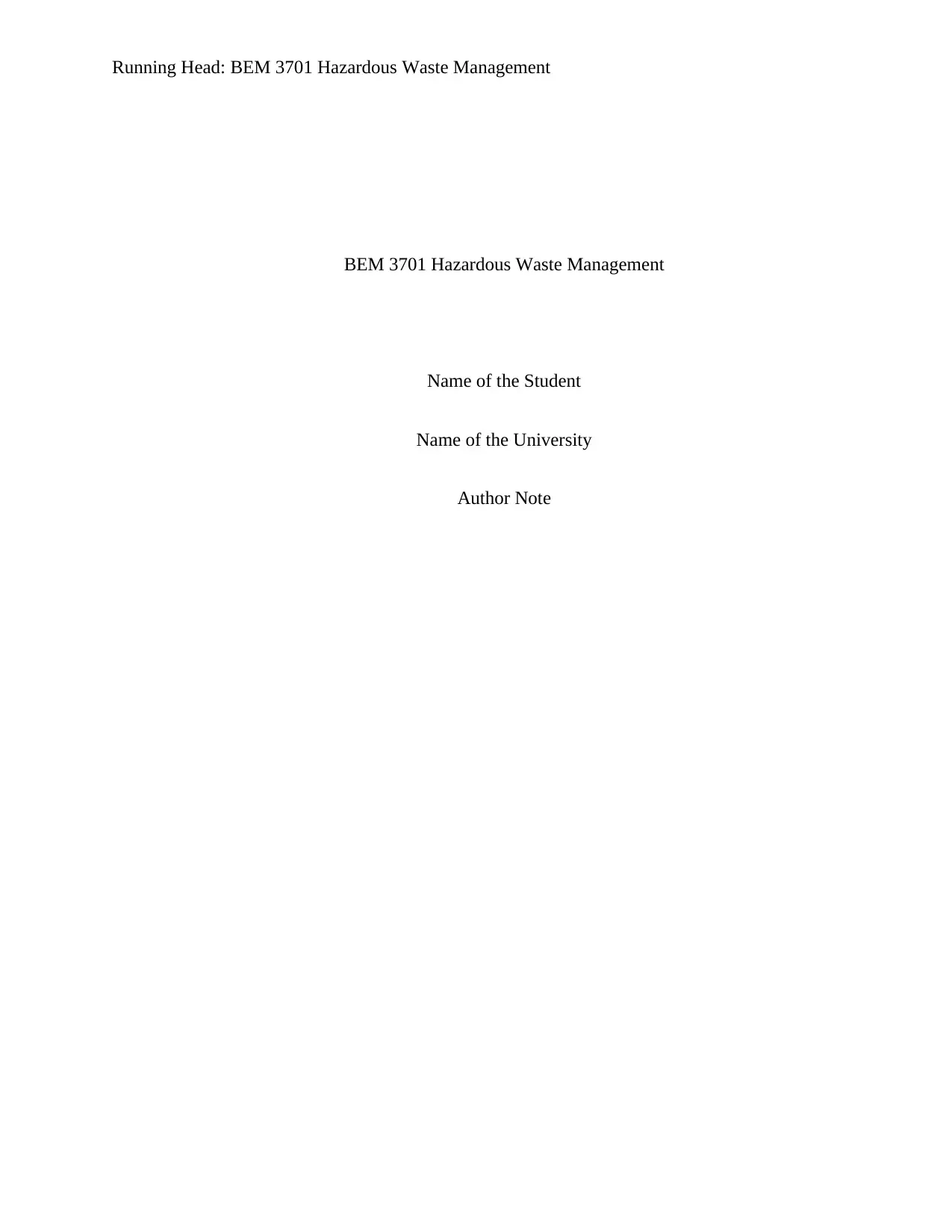
Running Head: BEM 3701 Hazardous Waste Management
BEM 3701 Hazardous Waste Management
Name of the Student
Name of the University
Author Note
BEM 3701 Hazardous Waste Management
Name of the Student
Name of the University
Author Note
Paraphrase This Document
Need a fresh take? Get an instant paraphrase of this document with our AI Paraphraser

1BEM 3701 HAZARDOUS WASTE MANAGEMENT
Introduction
The report is the response to my new responsibility as manager for a facility that
generates a large amount of used oil. In the past, the management of the company has not
properly managed its used oil. The report presents the health and environmental impact of the
used oil. The report deals with the recommendations for dealing with the used oil at the facility
to comply with the regulations.
The chemical characteristics of used oil
According to US EPA (Environmental protection agency) any synthetic or petroleum oil
is known as the used oil and is contaminated due to use by physical or chemical properties
(Betancor et al., 2017).
The used oil may be black or yellow brown in colour and the physical state is liquid or
oily. The minimum flash point is 1000 F minimum, and the viscosity may be variable. The
boiling and melting point is between 250-3000C. The used oil contains Arsenic, Lead,
Chromium, Cadmium and halogens. The soluble product of the used oil contains resins and
heavy substances. These substances cannot be desorbed from silica gel by acetone-benzene
mixtures or alcohol-benzene mixture. The used oil also contains low and high (C15-C50)
molecular weight aromatic and aliphatic fractions and paraffinic—naphthenic factors. The used
oils also contain small amount of the gasoline, N and S compounds (Speight, 2014).
The health and environmental effects of used oil
The health effects of the used oil include incidence of brain tumors, skin, rectal,
oesophageal, and intestinal cancer.
Introduction
The report is the response to my new responsibility as manager for a facility that
generates a large amount of used oil. In the past, the management of the company has not
properly managed its used oil. The report presents the health and environmental impact of the
used oil. The report deals with the recommendations for dealing with the used oil at the facility
to comply with the regulations.
The chemical characteristics of used oil
According to US EPA (Environmental protection agency) any synthetic or petroleum oil
is known as the used oil and is contaminated due to use by physical or chemical properties
(Betancor et al., 2017).
The used oil may be black or yellow brown in colour and the physical state is liquid or
oily. The minimum flash point is 1000 F minimum, and the viscosity may be variable. The
boiling and melting point is between 250-3000C. The used oil contains Arsenic, Lead,
Chromium, Cadmium and halogens. The soluble product of the used oil contains resins and
heavy substances. These substances cannot be desorbed from silica gel by acetone-benzene
mixtures or alcohol-benzene mixture. The used oil also contains low and high (C15-C50)
molecular weight aromatic and aliphatic fractions and paraffinic—naphthenic factors. The used
oils also contain small amount of the gasoline, N and S compounds (Speight, 2014).
The health and environmental effects of used oil
The health effects of the used oil include incidence of brain tumors, skin, rectal,
oesophageal, and intestinal cancer.

2BEM 3701 HAZARDOUS WASTE MANAGEMENT
The environmental effects include indoor air pollutions due to emissions (nitrogen di-
oxide, carbon di-oxide) from the indoor combustion of oil. Water and soil pollution may result
from oil spills to the environment eventually damaging the animal and plant life. Oil spills
changes the biological cycle in soil and the metals inhibit the nitrogen transformation, carbon
mineralisation. The human, vegetation and wildlife are exposed to harmful substances by
uncontrolled burning. Marine life is effected by film formed by soiled oil that prevents the
photosynthesis by plants. Fresh water is also polluted making it undrinkable (Witter et al., 2014).
Recommendations
At the facility it is recommended to manage the used oil in the following ways (Buttridge
et al., 2017)-
Training of employees- on use of signs and labels to segregate the used oils from
other wastes. Training should focus on educating the employees on the
importance of separating the used oil from wastes. The above ground tanks and
containers and fill pipes should be labelled with the word “Used Oil.”. Training
should be in accordance with “Resource Conservation and Recovery Act
(RCRA)” Training Module as per US EPA regulation
Use of leak proof closed container for storing used oil and discard use of
containers with rust or structural defects
Draining and collecting of the oil to be performed away from the drains on a
curved, covered and impermeable surface
The environmental effects include indoor air pollutions due to emissions (nitrogen di-
oxide, carbon di-oxide) from the indoor combustion of oil. Water and soil pollution may result
from oil spills to the environment eventually damaging the animal and plant life. Oil spills
changes the biological cycle in soil and the metals inhibit the nitrogen transformation, carbon
mineralisation. The human, vegetation and wildlife are exposed to harmful substances by
uncontrolled burning. Marine life is effected by film formed by soiled oil that prevents the
photosynthesis by plants. Fresh water is also polluted making it undrinkable (Witter et al., 2014).
Recommendations
At the facility it is recommended to manage the used oil in the following ways (Buttridge
et al., 2017)-
Training of employees- on use of signs and labels to segregate the used oils from
other wastes. Training should focus on educating the employees on the
importance of separating the used oil from wastes. The above ground tanks and
containers and fill pipes should be labelled with the word “Used Oil.”. Training
should be in accordance with “Resource Conservation and Recovery Act
(RCRA)” Training Module as per US EPA regulation
Use of leak proof closed container for storing used oil and discard use of
containers with rust or structural defects
Draining and collecting of the oil to be performed away from the drains on a
curved, covered and impermeable surface
⊘ This is a preview!⊘
Do you want full access?
Subscribe today to unlock all pages.

Trusted by 1+ million students worldwide
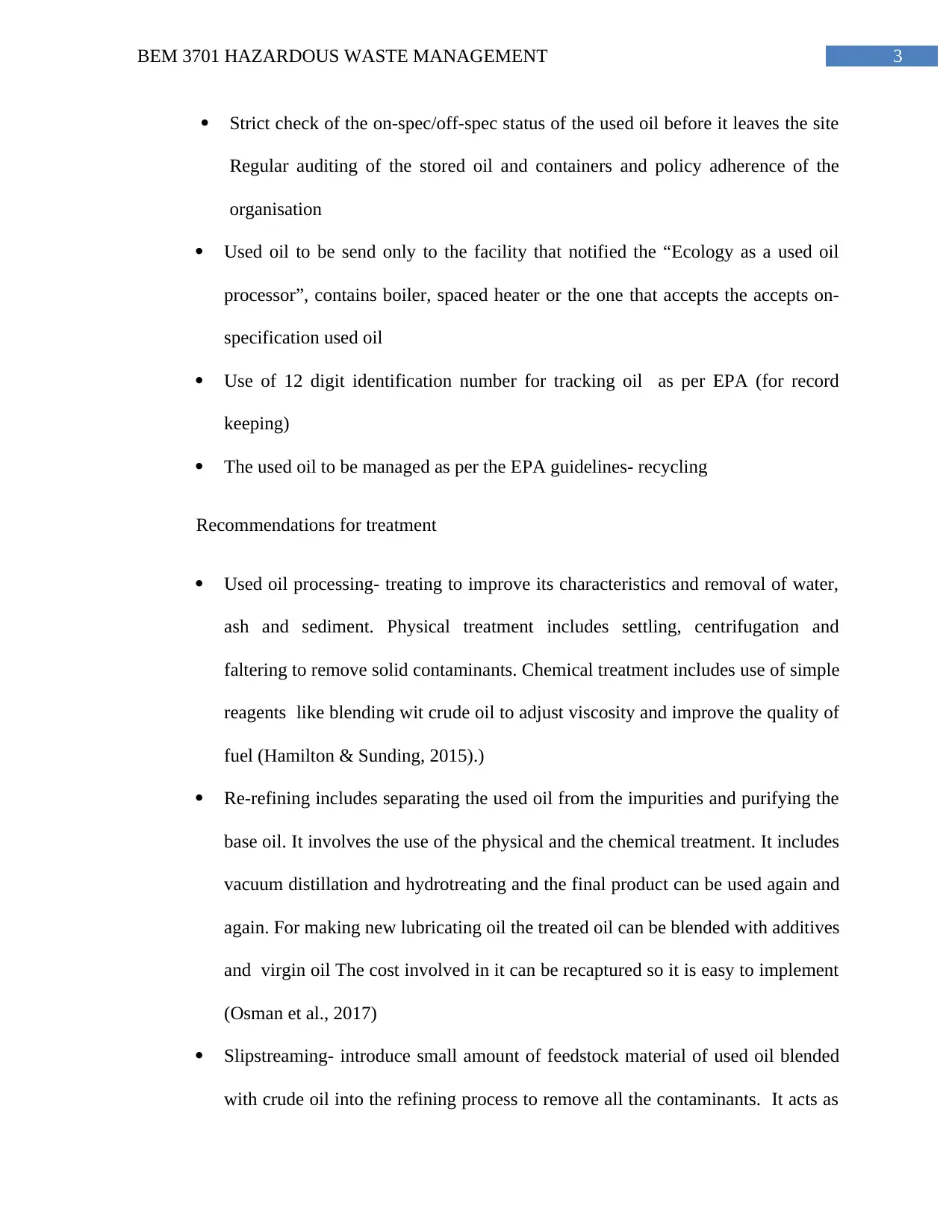
3BEM 3701 HAZARDOUS WASTE MANAGEMENT
Strict check of the on-spec/off-spec status of the used oil before it leaves the site
Regular auditing of the stored oil and containers and policy adherence of the
organisation
Used oil to be send only to the facility that notified the “Ecology as a used oil
processor”, contains boiler, spaced heater or the one that accepts the accepts on-
specification used oil
Use of 12 digit identification number for tracking oil as per EPA (for record
keeping)
The used oil to be managed as per the EPA guidelines- recycling
Recommendations for treatment
Used oil processing- treating to improve its characteristics and removal of water,
ash and sediment. Physical treatment includes settling, centrifugation and
faltering to remove solid contaminants. Chemical treatment includes use of simple
reagents like blending wit crude oil to adjust viscosity and improve the quality of
fuel (Hamilton & Sunding, 2015).)
Re-refining includes separating the used oil from the impurities and purifying the
base oil. It involves the use of the physical and the chemical treatment. It includes
vacuum distillation and hydrotreating and the final product can be used again and
again. For making new lubricating oil the treated oil can be blended with additives
and virgin oil The cost involved in it can be recaptured so it is easy to implement
(Osman et al., 2017)
Slipstreaming- introduce small amount of feedstock material of used oil blended
with crude oil into the refining process to remove all the contaminants. It acts as
Strict check of the on-spec/off-spec status of the used oil before it leaves the site
Regular auditing of the stored oil and containers and policy adherence of the
organisation
Used oil to be send only to the facility that notified the “Ecology as a used oil
processor”, contains boiler, spaced heater or the one that accepts the accepts on-
specification used oil
Use of 12 digit identification number for tracking oil as per EPA (for record
keeping)
The used oil to be managed as per the EPA guidelines- recycling
Recommendations for treatment
Used oil processing- treating to improve its characteristics and removal of water,
ash and sediment. Physical treatment includes settling, centrifugation and
faltering to remove solid contaminants. Chemical treatment includes use of simple
reagents like blending wit crude oil to adjust viscosity and improve the quality of
fuel (Hamilton & Sunding, 2015).)
Re-refining includes separating the used oil from the impurities and purifying the
base oil. It involves the use of the physical and the chemical treatment. It includes
vacuum distillation and hydrotreating and the final product can be used again and
again. For making new lubricating oil the treated oil can be blended with additives
and virgin oil The cost involved in it can be recaptured so it is easy to implement
(Osman et al., 2017)
Slipstreaming- introduce small amount of feedstock material of used oil blended
with crude oil into the refining process to remove all the contaminants. It acts as
Paraphrase This Document
Need a fresh take? Get an instant paraphrase of this document with our AI Paraphraser
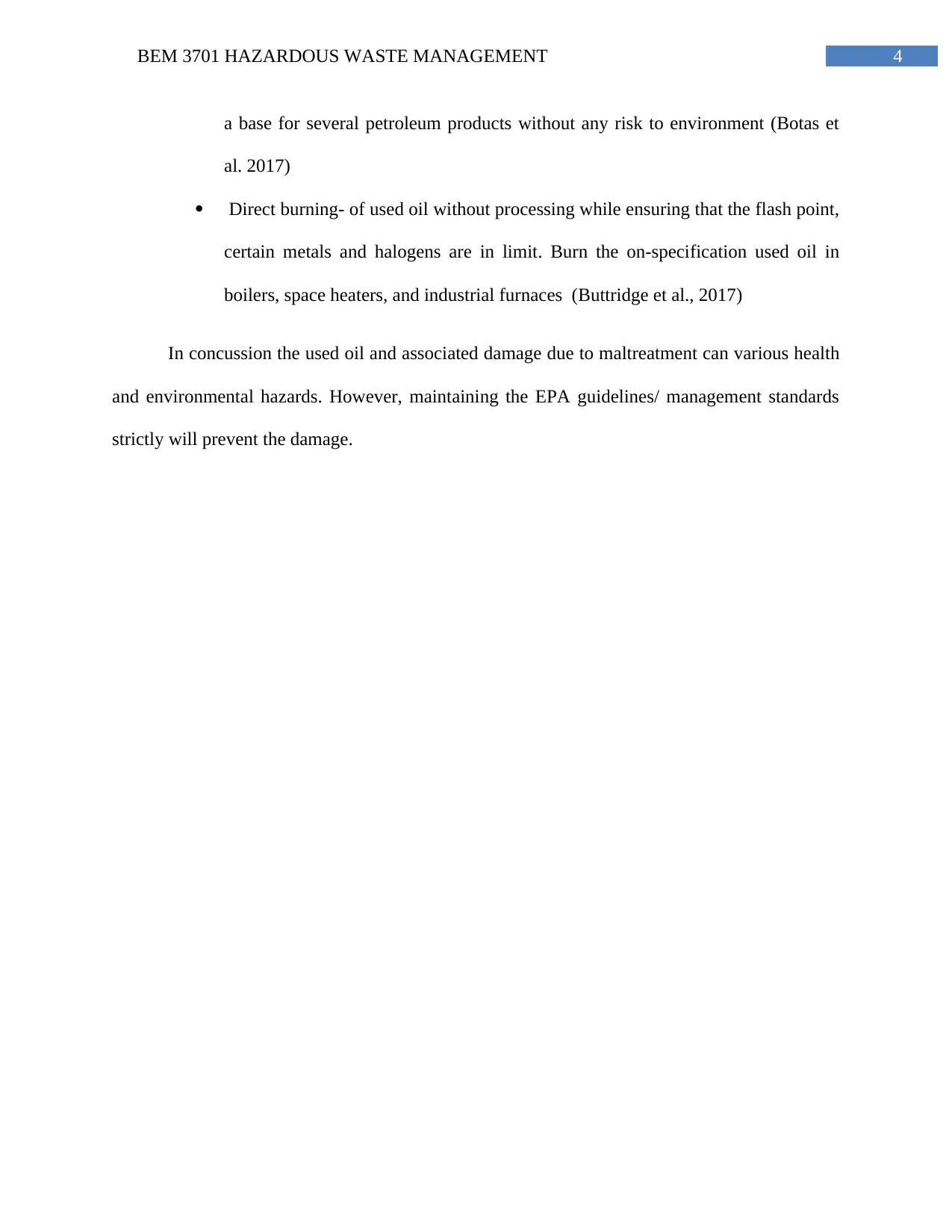
4BEM 3701 HAZARDOUS WASTE MANAGEMENT
a base for several petroleum products without any risk to environment (Botas et
al. 2017)
Direct burning- of used oil without processing while ensuring that the flash point,
certain metals and halogens are in limit. Burn the on-specification used oil in
boilers, space heaters, and industrial furnaces (Buttridge et al., 2017)
In concussion the used oil and associated damage due to maltreatment can various health
and environmental hazards. However, maintaining the EPA guidelines/ management standards
strictly will prevent the damage.
a base for several petroleum products without any risk to environment (Botas et
al. 2017)
Direct burning- of used oil without processing while ensuring that the flash point,
certain metals and halogens are in limit. Burn the on-specification used oil in
boilers, space heaters, and industrial furnaces (Buttridge et al., 2017)
In concussion the used oil and associated damage due to maltreatment can various health
and environmental hazards. However, maintaining the EPA guidelines/ management standards
strictly will prevent the damage.
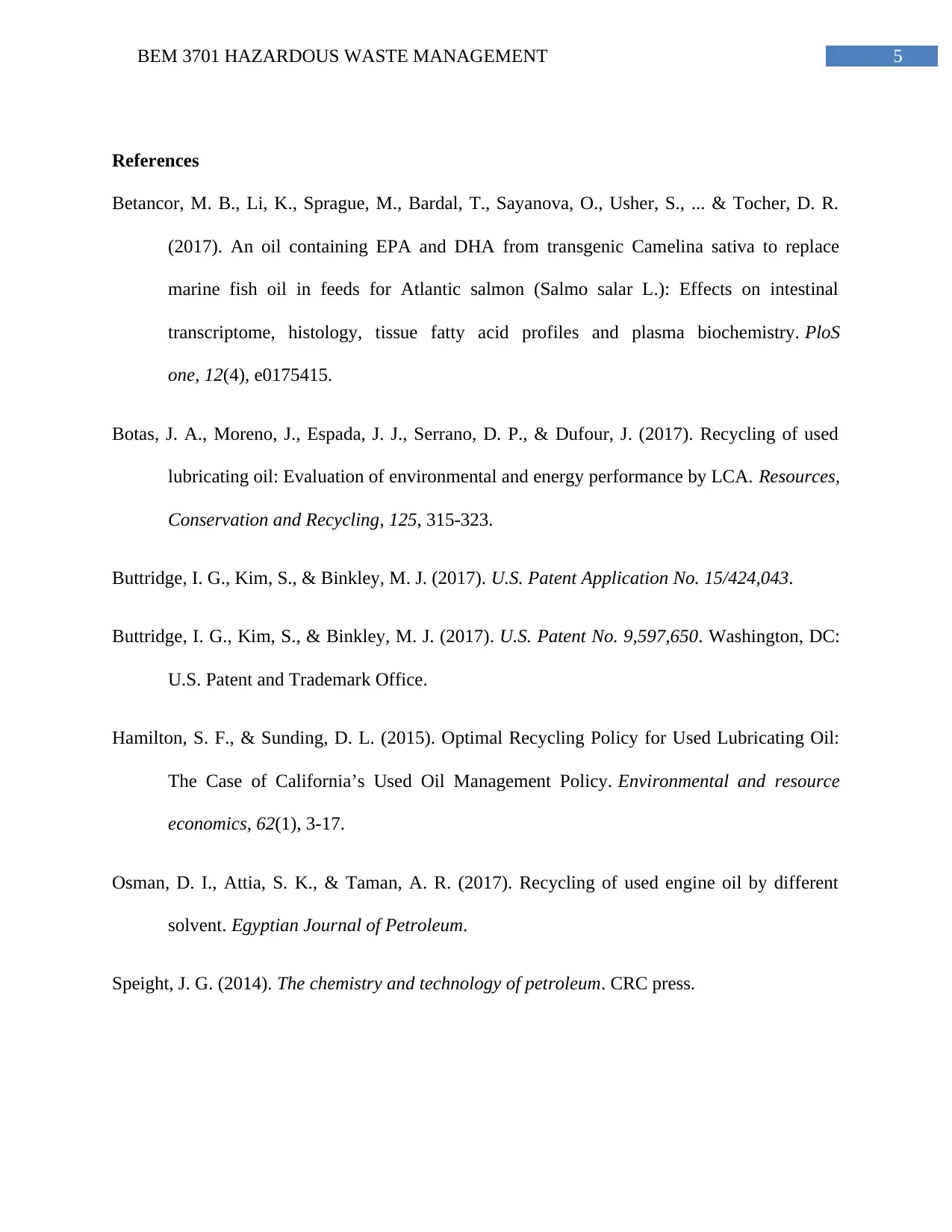
5BEM 3701 HAZARDOUS WASTE MANAGEMENT
References
Betancor, M. B., Li, K., Sprague, M., Bardal, T., Sayanova, O., Usher, S., ... & Tocher, D. R.
(2017). An oil containing EPA and DHA from transgenic Camelina sativa to replace
marine fish oil in feeds for Atlantic salmon (Salmo salar L.): Effects on intestinal
transcriptome, histology, tissue fatty acid profiles and plasma biochemistry. PloS
one, 12(4), e0175415.
Botas, J. A., Moreno, J., Espada, J. J., Serrano, D. P., & Dufour, J. (2017). Recycling of used
lubricating oil: Evaluation of environmental and energy performance by LCA. Resources,
Conservation and Recycling, 125, 315-323.
Buttridge, I. G., Kim, S., & Binkley, M. J. (2017). U.S. Patent Application No. 15/424,043.
Buttridge, I. G., Kim, S., & Binkley, M. J. (2017). U.S. Patent No. 9,597,650. Washington, DC:
U.S. Patent and Trademark Office.
Hamilton, S. F., & Sunding, D. L. (2015). Optimal Recycling Policy for Used Lubricating Oil:
The Case of California’s Used Oil Management Policy. Environmental and resource
economics, 62(1), 3-17.
Osman, D. I., Attia, S. K., & Taman, A. R. (2017). Recycling of used engine oil by different
solvent. Egyptian Journal of Petroleum.
Speight, J. G. (2014). The chemistry and technology of petroleum. CRC press.
References
Betancor, M. B., Li, K., Sprague, M., Bardal, T., Sayanova, O., Usher, S., ... & Tocher, D. R.
(2017). An oil containing EPA and DHA from transgenic Camelina sativa to replace
marine fish oil in feeds for Atlantic salmon (Salmo salar L.): Effects on intestinal
transcriptome, histology, tissue fatty acid profiles and plasma biochemistry. PloS
one, 12(4), e0175415.
Botas, J. A., Moreno, J., Espada, J. J., Serrano, D. P., & Dufour, J. (2017). Recycling of used
lubricating oil: Evaluation of environmental and energy performance by LCA. Resources,
Conservation and Recycling, 125, 315-323.
Buttridge, I. G., Kim, S., & Binkley, M. J. (2017). U.S. Patent Application No. 15/424,043.
Buttridge, I. G., Kim, S., & Binkley, M. J. (2017). U.S. Patent No. 9,597,650. Washington, DC:
U.S. Patent and Trademark Office.
Hamilton, S. F., & Sunding, D. L. (2015). Optimal Recycling Policy for Used Lubricating Oil:
The Case of California’s Used Oil Management Policy. Environmental and resource
economics, 62(1), 3-17.
Osman, D. I., Attia, S. K., & Taman, A. R. (2017). Recycling of used engine oil by different
solvent. Egyptian Journal of Petroleum.
Speight, J. G. (2014). The chemistry and technology of petroleum. CRC press.
⊘ This is a preview!⊘
Do you want full access?
Subscribe today to unlock all pages.

Trusted by 1+ million students worldwide
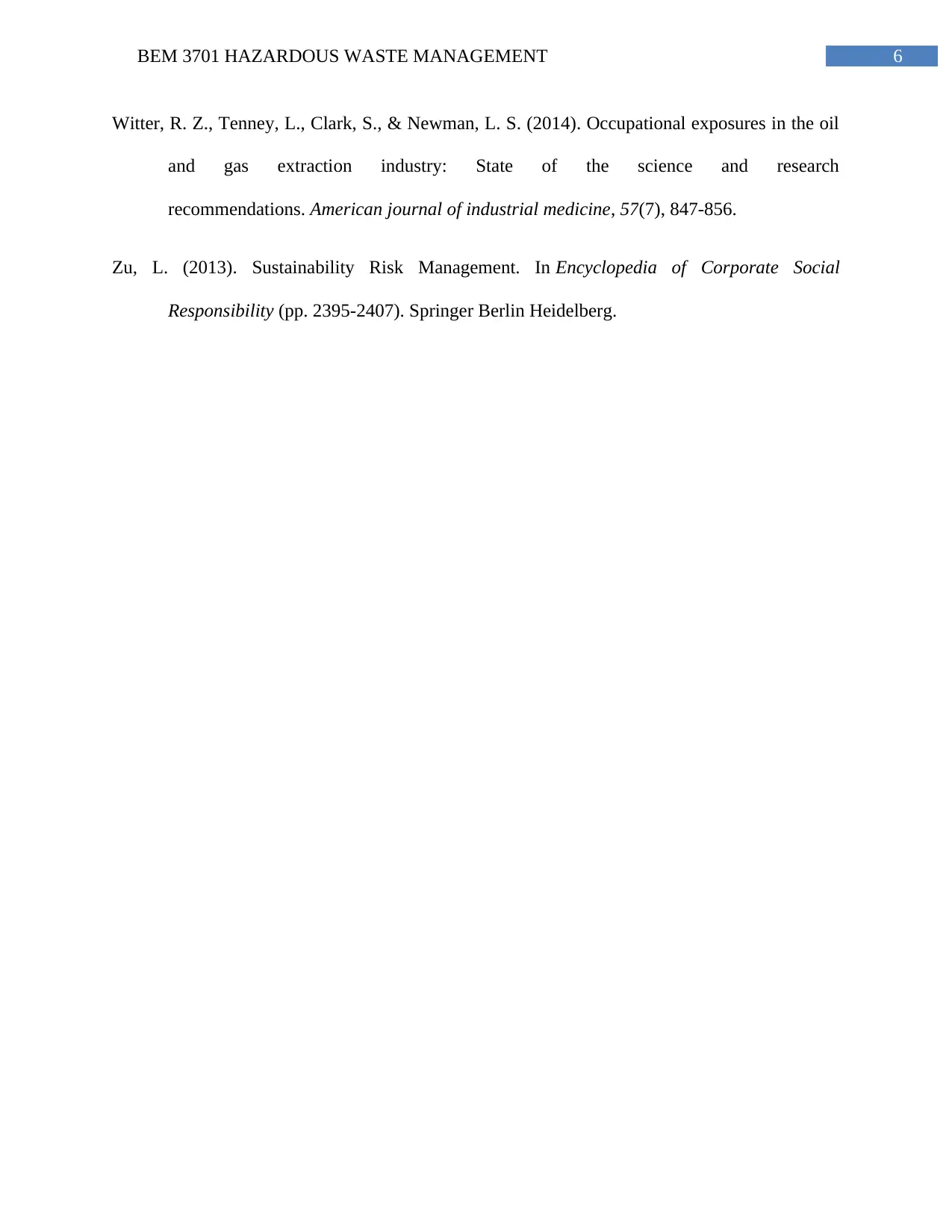
6BEM 3701 HAZARDOUS WASTE MANAGEMENT
Witter, R. Z., Tenney, L., Clark, S., & Newman, L. S. (2014). Occupational exposures in the oil
and gas extraction industry: State of the science and research
recommendations. American journal of industrial medicine, 57(7), 847-856.
Zu, L. (2013). Sustainability Risk Management. In Encyclopedia of Corporate Social
Responsibility (pp. 2395-2407). Springer Berlin Heidelberg.
Witter, R. Z., Tenney, L., Clark, S., & Newman, L. S. (2014). Occupational exposures in the oil
and gas extraction industry: State of the science and research
recommendations. American journal of industrial medicine, 57(7), 847-856.
Zu, L. (2013). Sustainability Risk Management. In Encyclopedia of Corporate Social
Responsibility (pp. 2395-2407). Springer Berlin Heidelberg.
1 out of 7
Your All-in-One AI-Powered Toolkit for Academic Success.
+13062052269
info@desklib.com
Available 24*7 on WhatsApp / Email
![[object Object]](/_next/static/media/star-bottom.7253800d.svg)
Unlock your academic potential
Copyright © 2020–2026 A2Z Services. All Rights Reserved. Developed and managed by ZUCOL.
